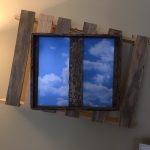Ian Hochberg walks slowly around his Mount Washington living room, gazing intently at each work of art hanging on the wall, all of which he personally created.
After a moment of contemplation, Hochberg, a tall, lanky man with an amiable disposition, notes that while he’s been a creative soul since birth, it took him a number of years to find his true artistic voice.
A Northwest Baltimore native and 1974 graduate of Pikesville High School, Hochberg, 63, has made a career out of assembling random objects he has discovered on area streets, alleyways, sidewalks, gutters and bridges.
The idea to create art from assorted found modern objects inspired Hochberg to open his own business, High Mountain Signs, in June of 1981. The shop, located in Hampden-Woodberry’s Meadow Mill business complex, creates signs, banners, awnings, flags, displays and graphics for scores of businesses throughout Maryland and beyond.
Jmore recently spoke withHochberg — a 1978 graduate of the Maryland Institute College of Art — abouthis art, business and plans to have exhibitions of his artwork in the nearfuture.
Jmore: What compelled you to become an artist?
Hochberg: Fromthe very beginning, I wanted to be an artist. My mother said I never likedcoloring books. I just did my own drawings. I just knew, from when I canremember, that art was my passion.
You became a bar mitzvah at Temple Oheb Shalom. Does being Jewish inform or influence your art in any way?
I grew up in a Reform household. My main expression of my religion is through a piece titled, “My Self Portrait,” highlighting my journey with my religion from birth to present day.

How does your signs business reflect your creativity and need for artistic expression?
The shapes, geometry and angles of the signs tie in with my art. The signs are a lot of work for something that will be read in two seconds and then forgotten.
My art has that same feel. It’s about making an impression quickly.
Your art’s message?
Lifeis challenging, but there is no message. When I begin a piece, I keep that inmind. The common thread that unconsciously appears in my art is there’s endlesschallenges, but to always go up. My art has angles, you can see in it theupward movement.
Your biggest artistic influences?
The people in my major [at MICA]. My major was graphic design and we worked closely together, and they helped shape the ideas of the art that I was doing at the time.
Anotherhuge influence for me was my professor, [MICA painting department chair] BarryNemett. I had him for freshman painting, and I had transferred in from [theUniversity of Maryland] College Park. He gave us an assignment to do a stilllife [painting[, and I didn’t do that at all. I went home, I gathered objects andcreated an assemblage. It had nothing to do with the assignment, so it startedan uproar in class. They thought it was a put-on.
Barry Nemett, however, looked at it and said, ‘Wait a minute, let’s examine this some more.’ My art that went opposite of what he had asked for ended up getting more attention than any of the still lifes. He gave me that chance, and I thank him for that.
Ever consider giving up art?
Yes,actually. I would ask myself, ‘Why am I doing this? Am I doing this because I have donethis all my life or because I reallywant to do this?’
I went for an aptitude test in my 30s to see what else I could do, and everything came back to continuing in the art field. Eventually, starting these [found object] pieces was a way to express what was going on in my life at that time. It was getting through that uneven period that gave me the freedom to do the art I do now.
Has your art evolved over the years?
There’sa freedom I haven’t felt before. One reason I love to create art is because I can. The expression of an artist is themost important part of any work.
Memorable responses to your artwork?
When friends and family come over, they are blown away. Everyone sees the art within the found objects put together. They see that there’s a sense of purpose in the art. One of my wife’s closest friends came over and told my wife that my work is ‘spiritual.’
What do you hope your work conveys to people?
Ifmy art elevates people, that would be great. Elevation can be anything, but itdoesn’tnecessarily have to be a religious elevation. It can just be growth.
Is your family supportive of your artistic endeavors?
Yes, absolutely. My grandfather was a printer, so the artistic lifestyle runs in my family. My family has told me my art is compelling and fascinating to them.
Any advice for budding artists?
Be open. It may be rough, but there’s merit behind art, and that is the true beauty behind the piece.
Lauren White is a Jmore editorial staff intern.





